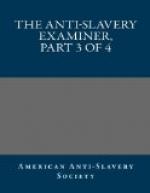DR. DEMMING, a gentleman of high respectability, residing in Ashland, Richland county, Ohio, stated to Professor Wright, of New York city,
“That during a recent tour at the south, while ascending the Ohio river, on the steamboat Fame, he had an opportunity of conversing with a Mr. Dickinson, a resident of Pittsburg, in company with a number of cotton-planters and slave-dealers, from Louisiana, Alabama, and Mississippi, Mr. Dickinson stated as a fact, that the sugar planters upon the sugar coast in Louisiana had ascertained, that, as it was usually necessary to employ about twice the amount of labor during the boiling season, that was required during the season of raising, they could, by excessive driving, day and night, during the boiling season, accomplish the whole labor with one set of hands. By pursuing this plan, they could afford to sacrifice a set of hands once in seven years! He further stated that this horrible system was now practised to a considerable extent! The correctness of this statement was substantially admitted by the slaveholders then on board.”
The late MR. SAMUEL BLACKWELL, a highly respected citizen of Jersey city, opposite the city of New York, and a member of the Presbyterian church, visited many of the sugar plantations in Louisiana a few years since: and having for many years been the owner of an extensive sugar refinery in England, and subsequently in this country, he had not only every facility afforded him by the planters, for personal inspection of all parts of the process of sugar-making, but received from them the most unreserved communications, as to their management of their slaves. Mr. B., after his return, frequently made the following statement to gentlemen of his acquaintance,—“That the planters generally declared to him, that they were obliged so to over-work their slaves during the sugar-making season, (from eight to ten weeks,) as to use them up in seven or eight years. For, said they, after the process is commenced, it must be pushed without cessation, night and day; and we cannot afford to keep a sufficient number of slaves to do the extra work at the time of sugar-making, as we could not profitably employ them the rest of the year.”




